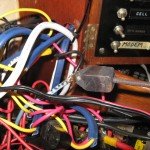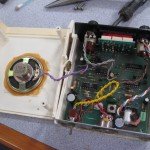Using Noodles to solve Electrical Problems.
One of our most used bits of equipment on board is the depth sounder, so repairing it was a priority when it refused to light up as we approached shallow water. As they say, you never know whatcha got until it has gone.
In moments like this, it is easy to forget that we can revert to traditional methods of sounding. In the same way that if a sum-log (marine speedometer) failed, one can calculate the speed of the boat by chucking a small log (yes, they used to do that) over the bow and timing its traverse past the stern. Bingo, a few calculations and you have the speed in knots. Re the depth sounder, similarly we have a back up. It is a heavy lead weight attached to a 6mm string marked at the depth of our keel, and two metre points after that. If we were to get tricky we would stick some tallow (old soap) on the base and thus be able to determine the nature of the bottom. Now what sounder today can do that? Indeed, we have, in the past used a lead to plumb (sorry for the pun) depths ahead. Marion at the bow swinging the lead with gusto ahead so it would be vertical, then shouting the numbers to me, much to the amusement of other boaters in the anchorage. Well, that was in 1979 in our first boat Wild Honey, and tech was a strange word.
Our depth sounder is also a low tech machine that displays the depth in red, and has one knob for on/off, and another for creating a depth alarm reading. Since electrical problems are usually only a short, or a poor connection, it was a matter of investigating where that short was. In my pessimistic way, usually, I go for the big end bearing first. Take the engine apart and remove the main crankshaft. So it was with this, off came the cover to reveal the inner marvels. Since the problem was intermittent, I suspected the switch. I took the start switch apart and cleaned the sliding contacts with alcohol and white cardboard. This helped, but the problem persisted.
The problem lay in contacts at the switch board end. Easily determined by use of the resistance setting on the portable meter. Wires had been crimped but somehow the connection failed. I soldered these wires together using my heavy copper iron heated on our gas stove. At the sounder end, I also shortened some narrow gauge wires and soldered some ends that joined to the heavy gauge wire coming from the switchboard. Reduce the resistance, improve the conductivity, and bingo we are back in business.
Noodles? Noodling out problems in electrical items is the term used to fix things. Do it logically and in sequence. Use a meter and use your head.


